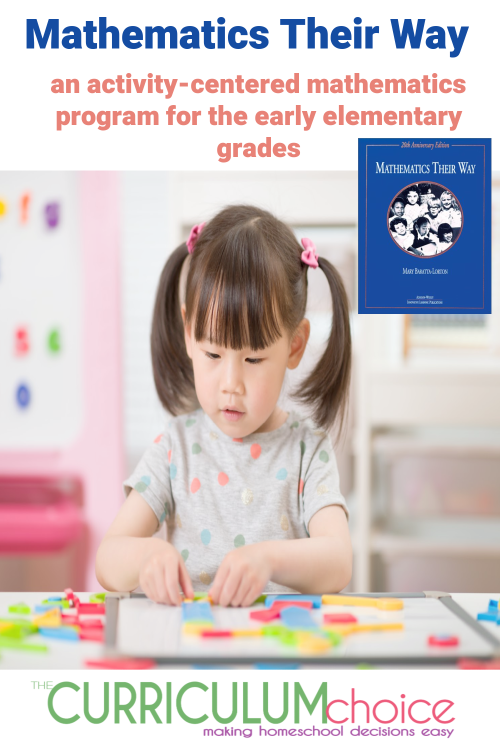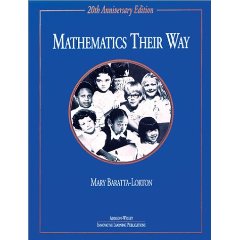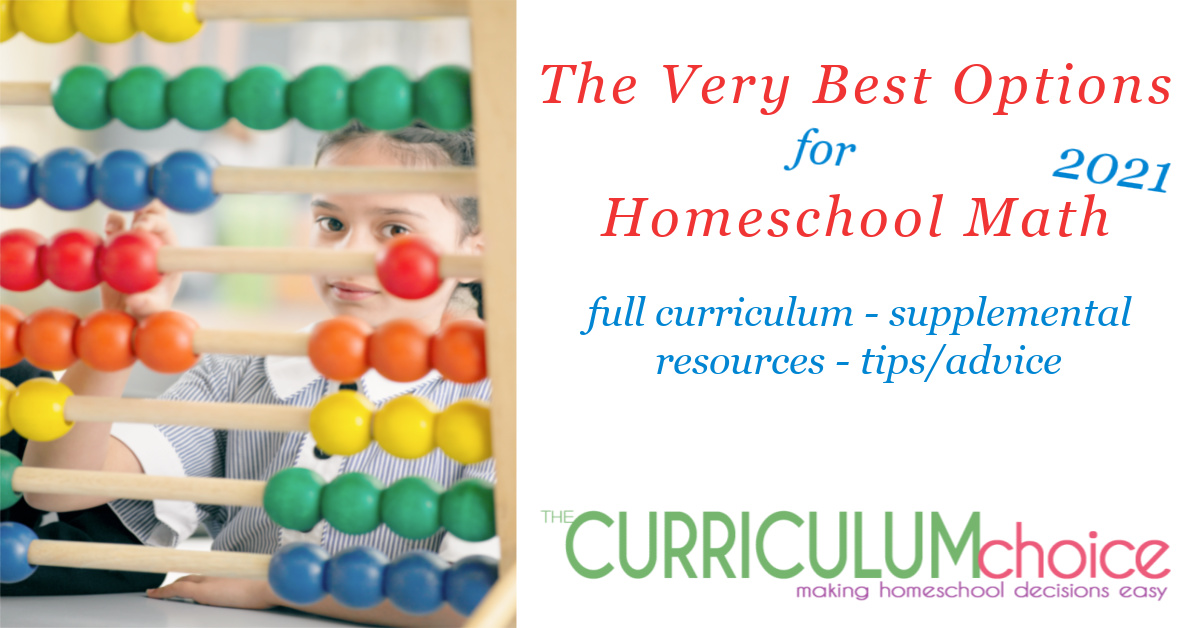Mathematics Their Way is an activity-centered mathematics program for the early elementary grades. (K-2)
Mathematics Their Way is a textbook written by Mary Baratta-Lorton and published by the Center for Innovation in Education, and later by Addison-Wesley (1995). The text grew out of her desire to mathematically reach all of the children in her inner city classroom, especially those who had not had much experience with math or who did not possess a natural penchant for math. It is intended for use by kindergarten through second grade, and utilizes a hands-on, activity-centered approach to teaching basic math skills for these levels.

About Mathematics Their Way
Mathematics Their Way contains over 200 activities, including sample teaching strategies, sample letters to parents, and blackline masters.
The new 25TH ANNIVERSARY EDITION OF MATH THEIR WAY includes:
- an index that correlates the activities in Mathematics Their Way and the Mathematics Their Way Summary Newsletter
- twelve chapter bookmarks with references to children’s literature that relate to the chapter topics
- a bibliography of math related teacher resources
Since it relies on hands-on activities, there is only a teacher’s book, though a collection of newsletters written by Mary Baratta-Lorton have also been collected and published as Summary Newsletter by Addison-Wesley. There are several other available resources, including a collection of full-size black-line masters.
The textbook is organized topically.
It opens with a chapter discussing methods for free exploration of the math manipulatives and materials. It then continues with:
- covering pattern (three chapters of increasing difficulty and depth)
- sorting and classifying
- counting
- comparing
- graphing
- number at the concept level
- number at the connecting level
- number at the symbolic level
- place value
While the topics at the beginning of the book are more basic than those in the second half, it is not a book to be approached strictly chronologically. Rather, it is intended as a buffet of math activities for the young learner.
Using Mathematics Their Way

Structured for use in a classroom of students participating in learning stations and full-class math experiences, multiple chapters may be utilized at the same time. The author included a loose schedule of chapters by grade, along with a general checklist of activities for the teacher, but the choice of activities is up to the family and situation.
Many activities draw from a variety of collected objects which serve as manipulatives. The items used are listed in a glossary at the back of the book. At first glance, the glossary of materials appears to be extensive, but the author’s intent was for the items to be every-day, easy to find objects. In fact, she asked her students to bring in many of them. So, while the items are not necessarily hard to locate or duplicate, and certainly do not have to be expensive, there is quite a bit of gathering to be done. I suggest that you gather most of them before beginning.
Things to Note:
There are a few things to know about the book. It was produced for classroom use, and at first glance, many of the activities seem contingent upon a room full of students. I have not found this to be a major problem. In our home school, we have adapted the activities to accommodate one or two learners, instead of the classroom for which it was initially written. There are a couple of activities that I have by-passed due to the number of students necessary to complete them, but by and large, the hands-on nature of the text has been a huge plus for my children. It has enabled them to truly learn math concepts, rather than rote math facts without any real basis.
Additionally, the book has tempered my natural impulse, which would have been to lean heavily on a workbook or more traditional textbook since I am not entirely comfortable teaching math. The program has encouraged me to let my children develop a more complete understanding of numbers and processes independent of paper math. My daughter has been allowed to develop an understanding of numbers and numerical processes without the burden of writing. Now that we are transitioning into paper math, the concepts are cemented enough that my daughter recognizes the processes that she is describing in writing and is comfortable working with them. This textbook leads to understanding, and only then to recording math.
How We Use Mathematics Their Way
In our case, I spent the summer before my daughter started Kindergarten gathering materials. I made it a family affair, so aunts and grandmothers pitched in as well, sending items as they found them. I decided to collect lids, small cars, small animal figures, erasers, beads, buttons, twist ties, plastic bread ties, and small acorns. I also worked on putting together the other necessary supplies. The things that I couldn’t find, I either substituted with something else or checked to see if they were really necessary. Then we got started with the hands-on math experience. We counted, sorted, classified, compared, and graphed using a variety of activities and methods. The kids—because they all wanted to play with the new “toys”—didn’t even realize that they were doing math. It seemed more like playing with Mama. And it was fun. And it was not high pressure. And my kids always got to “play” until they understood the math idea. And this Mama who wasn’t extremely comfortable teaching math, did just fine!
For Kindergarten
For Kindergarten, we used the activities in Mathematics Their Way almost exclusively. (I will mention that though I opted to use this book as the primary text for Kindergarten and first grade, it would be a lovely supplement to any math program. Its buffet-style, activity-laden nature could easily be gleaned for activities to complement math topics as they were studied.)
For 1st Grade
For first grade, we have continued using Mathematics Their Way, but I have added several living math books every week or so, choosing subjects that build and develop mathematically. We have even written a few things down, as we slowly transition into paper math. Even though I plan to use a textbook for guidance next year, and to include a lot more recording of math concepts, I will continue to use the hands-on approach that I have learned with Mathematics Their Way, because I think that it makes math “real” to little learners.
Purchasing Mathematics Their Way
The book’s publisher, Pearson Education, is no longer publishing this book. Copies of the book continue to be available through Amazon.com, eBay.com, and other book distributers. A free downloadable pdf copy of the book is also available through the Center’s website.
You can also purchase the Math Their Way Materials Kit through The Center for Innovation In Education.
- You can purchase a digital copy here.
- A spiral bound copy here.
More Mathematics Options

The Very Best Options for Homeschool Math – This is a collection of math resources, everything from full curriculum, to advice from other homeschool parents, and even supplemental resources.
~ Originally published January 2010, written by Susan, who is a homeschooling mom of three—a preschooler, an almost kindergartner, and a first grader. They spend their days reading on the couch, playing with numbers, and making big, fun messes in a Spirit-led, Well-Trained Mind-inspired classical-Charlotte Mason-traditional model of home education.

I love reading about math options because I want to approach math from as many perspectives/senses as possible for my children. I had never heard of Mathmatics Their Way! Thanks.
I agree with Tristan. This is a new title for me. Does sound useful although expensive. I’m always on the lookout for the “magic bullet” for math. 🙂
.-= Jimmie´s last blog ..Theodore Roosevelt President Study =-.
I used Math their Way when I taught Kindergarten a number of years ago. I loved it and so did the kiddos! I am going to use it for homeschooling my oldest (who is presently four and a half). I like to teach hands-on and he learns best that way!
While I absolutely love MTW’s approach to mathematics, in my experience it is cumbersome to use and adapt for homeschooling. The activities/plans are all designed to be used in the context of a classroom of more than 20 students, which means that most activities need to be adapted to 1:1 within a home — which is especially challenging when you are also working with children who are too young for the materials. I find that MTW takes a lot of advance planning and preparation, and while it encourages independence, setting up for it (let alone storing all the tiny materials!) is not always easy. (For example, in a school setting, a math activity center — with storage — can be permanently set up to encourage independent exploration of a variety of counting materials. At home, I need to be able to put things away quickly when we’re done with them, and to protect littler ones from choaking–not so great for the free exploration that the program requires!) I love the individual activities — even the approach to learning to write numerals is genius! — but I have found that, at least for this homeschooler, while much of it can be a wonderful supplement to any math program, it is not a realistic choice for a primary program.
What did you end up using for Math??
I was looking in my Math Their Way book and it has been a long time since I used it. I saw workjobs listed and page numbers, but was not sure where workjobs is in the book or was it a separate book. I was trying to find Easter Baskets.
I am sorry to tell you that Workjobs is a separate book. It is by the same author. Good luck finding what you are looking for!
Good news! Workjobs and Workjobs II can now be found on the Center for Innovation in Education’s website in a downloadable format. They are no longer in print.
There are other resources there as well.
Go to http://center.edu
Thanks for writing this review. I got a copy of the Mathematics Their Way book from a homeschool friend whose kids have graduated but had a hard time finding examples of current uses of it. I’ve been tempted to buy a more popular curriculum to make myself feel better about it all but now I think I’ll save some money and try this out.
Do you think I should buy the blackline masters that did not come with my version (I guess they do come with the anniversary version)? And while I’m asking questions, what the heck are blackline masters? 🙂
Thanks!
Hi, Tauna! Thanks for commenting!
I am glad that you found the review useful. Let me free you from feeling as if you have to do every activity–you don’t. Choose a few from each chapter to cover the concepts. Above all, have a good time with it!
Blackline masters are originals used to make copies. You could get them if you wanted. I did not have them, so I made the sheets that I needed. I didn’t make many–a geoboard sheet, a dot pattern sheet, and pattern block sheets (which I copied on colored paper and cut our for the kids to “record” their pattern block creations.)
Have fun!
Susan S.
I was the director of a preschool (where my daughter attended) that used Math Their Way for the 4’s & 5’s class. Another ‘sister’ preschool in our area used Math Their Way also. Although it’s an older curriculum, it’s still useful because it uses hands-on, active learning, which is the only way early childhood children should learn, and learn best. It also instills the learning of the CONCEPT of math–not just memorization and counting. I certainly wish in my 12 years of public school, I would have learned the concept of math and had a hands-on math class! Then maybe all those years & for the rest of my life, I would not have hated math!
I definitely plan to use Math Their Way for my daughter in our home school kindergarten. Although it’s an older curriculum, it applies the current educational trends proven by research and taught by professionals for state-licensed schools.
If you want a newer take on MT.W, check out the books by Kathy Richardson. She uses some of the MTW games, even the blackline masters, but as added more with lots of research. I have used them with my K4 class, and now am using the more advanced activities with my K5’s.
How can I purchase this curriculum?